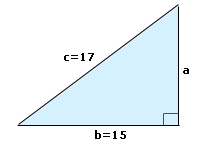Solved Examples and Worksheet for Pythagorean Theorem
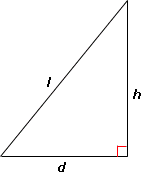
A. 48 feet
B. 16 feet
C. 28 feet
D. 36 feet
Step: 1
[Apply Pythagorean theorem.]
Step: 2
[Subtract d
Step: 3
[Substitute l d
Step: 4
= 400 - 144
[Apply exponents and simplify.]
Step: 5
= 256
Step: 6
⇒ h 256
[Take square root of both sides.]
Step: 7
= 16
Step: 8
Therefore, the height of the pole is 16 feet.
Correct Answer is : 16 feet
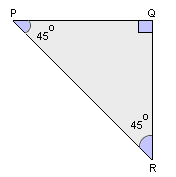
A. 9 inches and 9 inches
B. 6 inches and 4 inches
C. 4 inches and 4 inches
D. 2 inches and 3 inches
Step: 1
The triangle is a 45o-45o-90o triangle.
Step: 2
Length of PR = 9√2 inches.
Step: 3
In a 45o- 45o-90o triangle, length of hypotenuse is √2 times the length of leg.
Step: 4
In ΔPQR, PQ and QR are congruent legs and PR is the hypotenuse.
Step: 5
PR = PQ√2
Step: 6
PQ = PR/√2
[Divide each side by √2.]
Step: 7
PQ = 9√2/√2
[Replace PR with 9√2.]
Step: 8
PQ = 9 inches
[Simplify.]
Step: 9
Since the lengths of two legs are equal in 45o-45o-90o triangle, PQ = QR = 9 inches.
Step: 10
The lengths of PQ and QR are 9 inches and 9 inches.
Correct Answer is : 9 inches and 9 inches

A. 5 units
B. 12 units
C. 8 units
D. 10 units
Step: 1
If one angle of the triangle is 90°, then the triangle is a right triangle.
Step: 2
The side opposite to right angle is hypotenuse.
Step: 3
Let x
Step: 4
According to Pythagorean theorem, in a right triangle, square of the hypotenuse = sum of the squares of other two sides.
Step: 5
Applying Pythagorean theorem, 132 = 122 + x
Step: 6
169 = 144 + x
Step: 7
169 - 144 = x
[Subtract 144 from both the sides.]
Step: 8
25 = x
Step: 9
√25 = x
5 =x
5 =
Step: 10
The length of the third side of the triangle is 5 units.
Correct Answer is : 5 units
A. 17.09 ft
B. 18.09 ft
C. 15.85 ft
D. 16.97 ft
Step: 1
Let s d
Step: 2
All the angles of a square are right angles. So, the diagonal of the square will be the hypotenuse of the right triangle formed by two adjacent sides and the diagonal.
Step: 3
[Apply Pythagorean theorem.]
Step: 4
[Substitute s
Step: 5
[Apply exponents and simplify.]
Step: 6
[Take square root on both sides.]
Step: 7
The total distance Justin walked is 16.97 ft.
Correct Answer is : 16.97 ft
Step: 1
From the figure, c b
Step: 2
[Write Pythagorean theorem.]
Step: 3
[Subtract b
Step: 4
[Substitute for b c
Step: 5
[Apply exponents and simplify.]
Step: 6
[Take square root of both sides.]
Step: 7
The value of a
Correct Answer is : 8
A. 11 feet
B. 5 feet
C. 8 feet
D. 14 feet
Step: 1
The length of the ladder l
Step: 2
The distance from the foot of the ladder to the wall, d
Step: 3
Let h
Step: 4
[Write Pythagorean theorem.]
Step: 5
[Subtract d
Step: 6
= 102 - 62
[Substitute l h
Step: 7
= 100 - 36
[Apply exponents and simplify.]
Step: 8
= 64
Step: 9
[Take square root of both sides.]
Step: 10
= 8
Step: 11
Height of the wall = 8 feet.
Correct Answer is : 8 feet
A. 25 inches
B. 20 inches
C. 15 inches
D. None of the above
Step: 1
The lengths of hypotenuse and shorter leg of a right triangle are in the ratio 5:3
Step: 2
Let the length of hypotenuse and shorter leg be 5k k
Step: 3
Let the length of longer leg be x
Step: 4
[Apply Pythagorean theorem.]
Step: 5
[Evaluate powers.]
Step: 6
[Subtract and find the positive square root.]
Step: 7
The perimeter of triangle = 60 inches.
Step: 8
Perimeter of the right triangle = 5k k k k
Step: 9
12k
Step: 10
[Divide both sides with 12 and simplify.]
Step: 11
The length of longer leg = 4k
Correct Answer is : 20 inches
A. 5
B. 7 ft
C.
D.
Step: 1
Let a c
Step: 2
Then, a c
Step: 3
Let b
Step: 4
According to Pythagorean theorem, hypotenuse2 = sum of the squares of other two sides.
Step: 5
Step: 6
42 = 32 + b
[Substitute c a
Step: 7
16 = 9 + b
Step: 8
[Subtract 9 from both the sides.]
Step: 9
Step: 10
Step: 11
The length of the other side = 7
Correct Answer is : 7
A. 35.47 ft
B. 33.23 ft
C. 35.35 ft
D. 37.47 ft
Step: 1
Let s d
Step: 2
All the angles of a square are right angles. So, the diagonal of the square will be the hypotenuse of the right triangle formed by two adjacent sides and the diagonal.
Step: 3
[Apply Pythagorean theorem.]
Step: 4
[Substitute s
Step: 5
[Apply exponents and simplify.]
Step: 6
[Take square root on both sides.]
Step: 7
The total distance Jim walked is 35.35 ft.
Correct Answer is : 35.35 ft
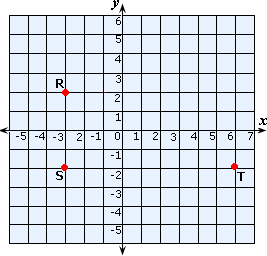
A. 9 units
B. 9.85 units
C. 10 units
D. 8.75 units
Step: 1
Plot the points R(- 3, 2), S(- 3, - 2) and T(6, - 2) in a Cartesian plane and join them.
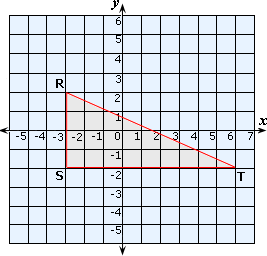

Step: 2
Distance between the point R and the point S = 2 - (-2) = 4 units
[Difference between the y
Step: 3
Distance between the point S and the point T = 6 - (-3) = 9 units
[Difference between the x
Step: 4
Distance between Andrew and Peter = Distance between the point R and the point T
Step: 5
Since ΔRST is a right-angled triangle,
RT2 = RS2 + ST2
RT2 = RS2 + ST2
[Pythagoras′ theorem.]
Step: 6
RT2 = 42 + 92
[Substitute the values.]
Step: 7
RT2 = 16 + 81 = 97
[Add.]
Step: 8
RT = 9 7
[Take square root on both sides.]
Step: 9
Therefore, the distance between Andrew and Peter is 9.85 units.
Correct Answer is : 9.85 units
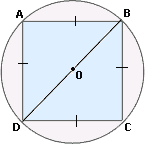
A. 5
B. 10 in.
C. 5 in.
D. 10
Step: 1
The radius of the circle OB = 5 in.
Step: 2
Diameter of the circle, BD = 10 in.
[diameter = 2 × radius.]
Step: 3
From right triangle BDC, BD2 = BC2 + CD2
[Apply Pythagorean theorem.]
Step: 4
BD2 = BC2 + BC2
[Since all sides of a square are equal,replace CD with BC.]
Step: 5
102 = 2BC2
[Substitute BD.]
Step: 6
100 = 2BC2
[Simplify.]
Step: 7
BC2 = 100 2
[Divide by 2 on both sides.]
Step: 8
BC = 5 0 2
[Take square root of both sides.]
Step: 9
The length of side of square = 52
Correct Answer is : 52
A. 91 inches
B. 84 inches
C. 35 inches
D. None of the above
Step: 1
The two legs of a right triangle are in the ratio 5:12
Step: 2
Let the length of two legs be 5k k
Step: 3
Hypotenuse2 = (5k k
[Apply Pythagorean theorem.]
Step: 4
Hypotenuse2 = 25k k
[Apply exponents .]
Step: 5
= 169k
[Simplify.]
Step: 6
Hypotenuse = 1 6 9 k 2 k
[Take square root of both sides.]
Step: 7
The perimeter of right triangle = 210 inches.
Step: 8
Perimeter of the right triangle = 5k k k k
Step: 9
30k
[Equate perimeters]
Step: 10
[Divide by 30 on both sides.]
Step: 11
Hypotenuse = 13k
[Substitute k
Step: 12
The length of hypotenuse = 91 inches.
Correct Answer is : 91 inches
A. 12 inches
B. 9 inches
C. 18 inches
D. 4 inches
Step: 1
The lengths of hypotenuse and shorter leg of a right triangle are in the ratio 5:3
Step: 2
Let the length of hypotenuse and shorter leg be 5k k
Step: 3
Let the length of longer leg be x
Step: 4
[Apply Pythagorean theorem.]
Step: 5
[Evaluate powers.]
Step: 6
[Subtract and find the positive square root.]
Step: 7
The perimeter of triangle = 36 inches.
Step: 8
Perimeter of the right triangle = 5k k k k
Step: 9
12k
Step: 10
[Divide both sides with 12 and simplify.]
Step: 11
The length of longer leg = 4k
Correct Answer is : 12 inches
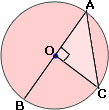
A. 17 cm
B. 17
C. 34
D. 2
Step: 1
The diameter of the circle O = 34 cm = AB
Step: 2
Radius of the circle OA = OC = 34 2
[Radius = Diameter 2
Step: 3
OAC is a right triangle.
Step: 4
AC2 = OA2 + OC2
[Apply Pythagorean theorem]
Step: 5
AC2 = (17)2 + (17)2
[Replace OA and OC with 17.]
Step: 6
AC2 = 289 + 289 = 578
[Apply exponents and simplify.]
Step: 7
AC = 5 7 8 = 1 7 2
[Find the positive square root.]
Step: 8
The length of the chord AC = 172
Correct Answer is : 172
- Parallel Lines and Transversals-Gr 8-Solved Examples
- Angle Sum Theorem of a Triangle-Gr 8-Solved Examples
- Exterior Angle Theorem-Gr 8-Solved Examples
- Distance Between Two Points-Gr 8-Solved Examples
- Transformations-Gr 8-Solved Examples
- Volume of Cylinders-Gr 8-Solved Examples
- Volume of Cones-Gr 8-Solved Examples
- Volume of a Sphere-Gr 8-Solved Examples
Related Worksheet
- Pythagorean Theorem
